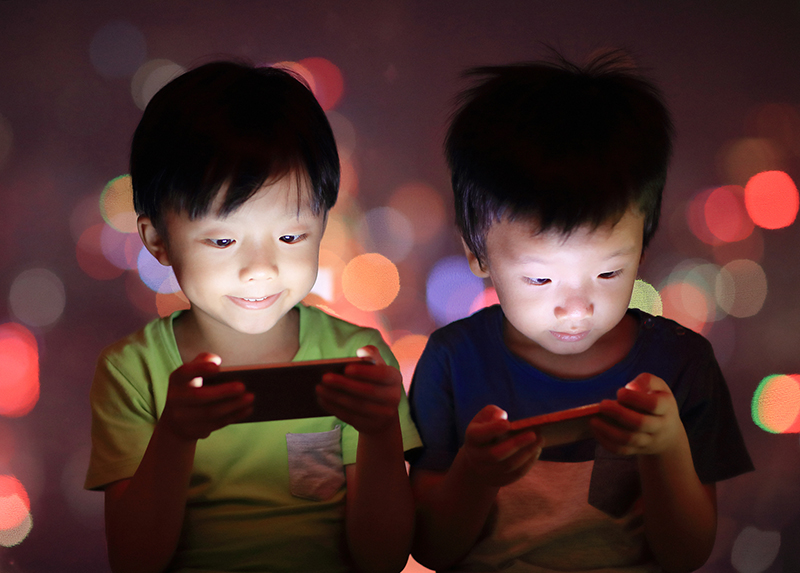Families For Life | Screen Time-Young Children

Screen time is the time you spend each day using devices with screens, like TVs, video consoles, smartphones and tablets. There are benefits and risks to using these devices, so a healthy family lifestyle includes limits on daily screen time.
What is screen time?
Screen time is the time you spend watching TV or DVDs, using computers, playing video or hand-held computer games, or using tablets or smartphones.
Screen time can be:
interactive – for example, playing video games, communicating via Skype, or using online tools to draw pictures
not interactive – for example, sitting still and watching movies, TV programmes or YouTube videos
educational – for example, doing maths homework online
recreational – for example, playing games or watching videos for fun.
Screen time guidelines
Child development experts recommend limiting children’s daily screen time. This is because real-life interactions with you and others are much better for your child’s wellbeing, learning and development.
The latest guidelines from the MOH's Guidance on screen use suggest that:
children under 18 months should have no screen time, other than interactive video-chatting
children aged 18 months to 6 years should have no more than one hour a day of screen time outside of school, where possible, with adults watching or playing with them to help them understand what they are watching
children aged 7 to 12 years should have no more than 2 hours a day of screen time unless it is related to school work.
What do screen time limits mean for your child?
Screen time limits are about making sure your child enjoys lots of healthy, fun activities – both with and without screens.
Limits mean looking at the time your child spends on screens and making sure it doesn’t get in the way of sleep and activities that are good for her development. These activities include things like physical play, reading, creative play like drawing, and social time with family and friends.
Limits don’t mean you should stop your child from watching TV or playing video games because he uses screens at school or for homework.
These guidelines aim to help you manage your family’s media use in a screen-filled world. The MOH Guidance on Screen use suggests a good way to do this is by developing a collaborative screen use plan or timetable. Your plan could cover things like screen-free areas in your house, screen-free times, and programmes and apps that are OK for your children to use.
Benefits of screen time
Television, movies, video games and the internet can be a positive influence on your child. This is especially when:
you get involved when your child is using them and help your child make good choices about what games to play or things to watch
you get involved and talk with your child about what’s going on in the game or programme so she understands it.
your child uses good-quality content on screens – for example, playing a video game that involves solving creative puzzles to progress to higher levels
using screens gives your child new ideas for traditional play – for example, playing Minecraft might get your child interested in designing buildings on paper
using screens helps your child learn new skills – for example, doing a video about a school excursion might help your child learn video-editing skills.
How do you know whether a TV show, movie, app or video game is of good quality? Our article on how your child can benefit from media explains.
Risks of screen time
Screen time can have physical, developmental, safety and other risks. If you reduce the amount of time your child spends using screens, you can reduce the risks for your child.
Physical problems
Using screens can cause physical problems. For example:
Looking at a screen intensely can cause sore, irritated and dry eyes, headaches and fatigue.
Looking down at a device can make your child’s neck and spine uncomfortable.
Being inactive for long periods using a screen can lead to a less active lifestyle, which could lead to obesity.
You can reduce these risks by encouraging your child to:
regularly look away from the screen into the distance
keep his neck upright when he’s using a phone or tablet
take regular breaks to get up and move around
make physical activity part of his daily life.
Development issues
Too much screen time can have an impact on children’s language development and social skills. This is because children need real-life interactions to develop these skills. Too much screen time can also affect older children’s development – for example, it can affect their ability to have conversations, maintain eye contact, pay attention in school or read body language.
Too much screen time can also result in children missing out on developing a wide range of interests, and the friends and learning associated with these interests.
You can reduce this risk by making sure your child balances time spent using screens with other activities.
Safety
Your child could encounter dangerous material or people on the internet.
You can reduce this risk by taking some practical internet safety precautions like checking the privacy settings on apps that your child uses. You can also help your child learn how to use the internet safely, responsibly and enjoyably – for example, by talking to your child about not sharing personal details online.
Media messages
Screen-based media can influence children and their behaviour – for example, children can copy or be influenced by negative behaviour, sterotypical representations of gender, violent imagery or coarse language they see in advertising and other media.
You can reduce this risk by helping your child develop media literacy, so that she can understand and question media messages.
© raisingchildren.net.au, translated and adapted with permission
Explore more